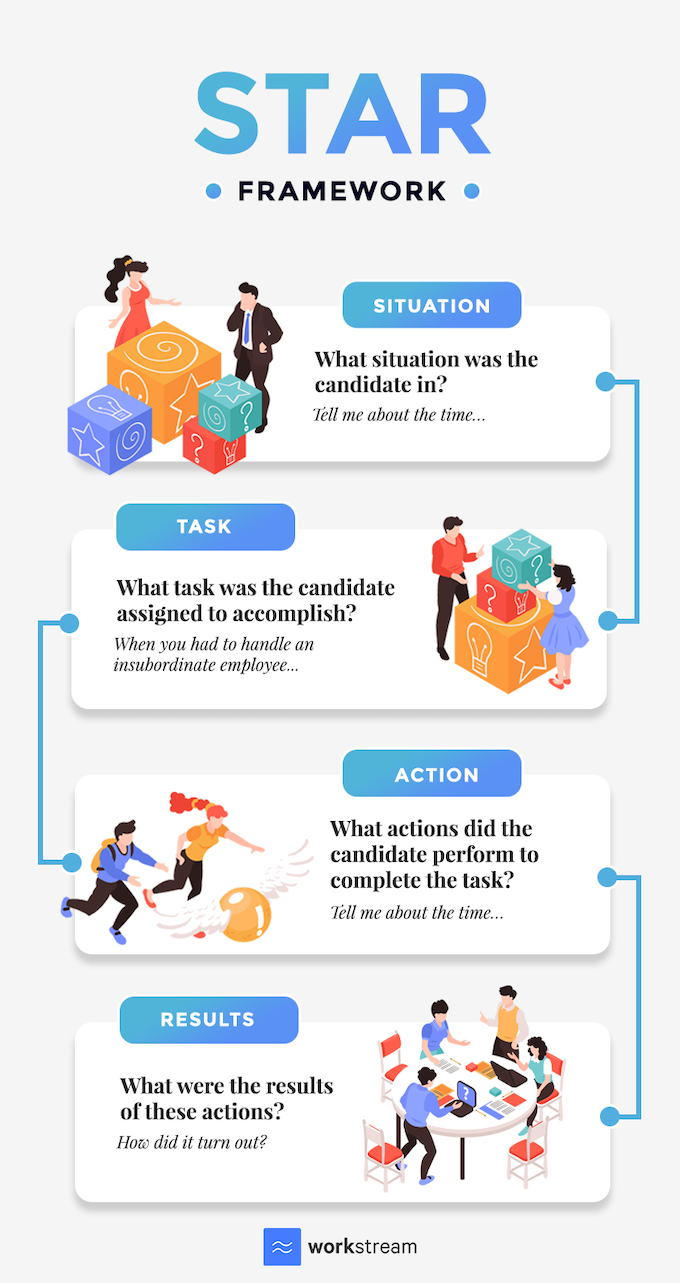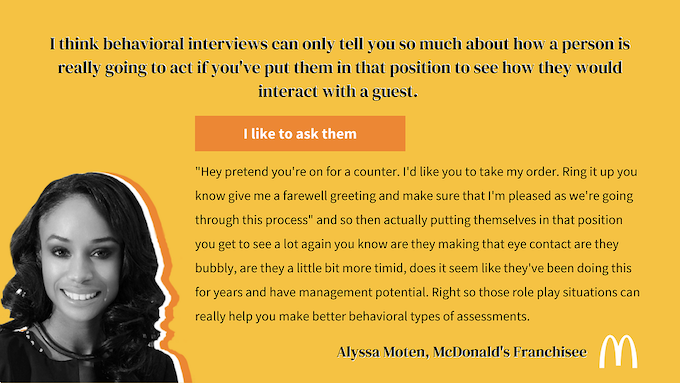Interviewing candidates is an art that is often overlooked. As a hiring manager or recruiter, you may find that interviewing comes very naturally, especially if you enjoy engaging in conversations for example starting with asking real life questions. Behavioral interviews are an effective way to assess a candidate's potential performance during a job interview based on their past experiences. Unfortunately, many interviewers often fail to ask the right questions - ones that can help gain insight into candidates’ experiences and assess who they are as professionals. Ideally, you’ll want to walk out of the interview session with a deeper understanding of the candidate and whether he or she is a great fit for the role and culture.
Behavioral interviews are by far the most effective way to assess a candidate’s potential of performing well at a job based on their past behavior and past experiences. This helps employers understand how these candidates would behave and react in similar situations and challenging situations along with their past performance that are relevant to the job role. Before conducting any interviews, employers must define what they are looking for in a candidate, starting with a clear job description.
In this article, we will be showing you the RIGHT WAY of preparing and conducting a successful behavioral interview tips.
Good job candidates can smell the lack of preparation on your part as a hiring manager right away. Being prepared with targeted questions can elevate your employer branding, which could very well determine if they’ll accept your job offer.
Why Conduct Behavioral Interviews
Behavioral interviews are an accurate predictor of future performance
To find the right candidate for a position, hiring managers should come up with interview questions that gauge applicants’ behaviors in addition to their skillsets and communication skills. Common behavioral interview questions are one of the most accurate predictors of a candidate’s future performance in identical situations by exploring historical experiences.
Behavioral interviews are objective and structured
The behavioral interviewing technique is part of a group of interviewing methods known as structured interviews. Structured interviews are used to objectively evaluate candidates and compare them for a position in your company by asking a set of questions relevant to the job and based on specific situations. These sets of questions tend to have a predetermined rating scale that helps the employer identify the best candidates for a position based on the answers that candidates provided. Employers must define what they are looking for in a candidate, including assessing their adaptability. Adaptability is a crucial soft skill that enables individuals to thrive in dynamic work environments, navigate change effectively, and embrace new challenges.
Behavioral interviews allow for fair evaluation and fewer chances of bias
Structured interviews make it easier for hiring managers to complete the job selection process fairly. This is because every candidate gets assessed using the same set of questions, which helps analyze the candidate’s ability to deliver on job duties and assess their soft skills.
Why Behavioral Questions are Important when Hiring Hourly Employees
According to a survey by PeopleMatter, the annual turnover rates of hourly employees across various industries are over 49% and it costs businesses a whopping $4,969 per employee. This is no surprise, considering the exorbitant cost of hiring (think job postings, wages of hiring managers, training costs). By identifying the right candidate, businesses can lower the risk of turnover, and instead repurpose the cost savings towards incentivizing employees through training and bonuses.
Three main factors determine an ideal hourly employee:
|
Availability Retention Conflict resolution |
By crafting your behavioral questions that touch on these three factors, you will be better able to identify the right candidate for the job. Interviewers should prompt further to get detailed answers. Such concrete examples include:
-
Can you elaborate on the situation?
-
What exactly did you do?
-
How did it turn out?
-
What specific roles were you taking on at that moment?
How to Prepare for Behavioral Interviews
Before conducting any interviews, employers must define what they are looking for in a candidate.
CAPS is a simple and highly effective framework for defining your ideal candidate.
|
Capacities - the physical and mental requirements to do the job Attitudes - customer service skills, dependability, etc. Personality - the traits needed such as temperament and assertiveness Skills - what is required to perform well on the job |
You may also apply the KSAOs Framework to supplement this preparation process.
- What knowledge, skills, abilities, and other characteristics (KSAOs) are required for one to excel in this job function?
- What behaviors are critical to the growth of my organization?
- What competencies are cardinal to the success of my company that I should check in candidates?
The behavioral interviewing technique adopts the competency-based approach when determining the right skills and behaviors for a position. According to Wikijob, competencies are behaviors or traits other than skills that recruiters have decided are suitable for the applicants of a job to possess. Competencies define an individual's ability to successfully carry out his or her skill in line with the company’s culture and handling difficult situations.
Defining your ideal candidate shouldn’t be overly time-consuming. A great trick would be to look at the requirements for some of your current job positions and augment them accordingly.
Here’s an example to demonstrate the difference between competency and skills:
5 people may be high-skilled in customer service, but perhaps only 3 can match your company’s culture. This can be time management, being an active team player, and working efficiently under high pressure.
Skills are undoubtedly critical when identifying the right candidate for a role. But, in isolation, it is essential to assess if the individual will be successful in the position and have a healthy talent cycle once they join your company.
By interviewing candidates based on competencies, employers determine if the job candidate can perform the duties required while still being the right fit for the organization. Based on the information gathered, a hiring manager can tell if the candidate matches the company’s culture or not apart from possessing the skill.
For example, a skilled, but extremely impolite barista might be able to prepare beverages at an impressive speed. Nonetheless, the inability to communicate effectively with co-workers and even customers could be detrimental to both the work environment and the customer experience. As a hiring manager, you need to determine whether it’s feasible to make the trade-off between hard skills and workplace behavior.
After determining the competencies and the problem solving skills you are looking for in a candidate, the next step is to formulate the interview questions.
How to Formulate Behavioral Interview Questions
behavioral-based interview questions should be formulated to extract information about an applicant’s past experiences that match the competencies of the position and your business rather than traditional interviews. This ensures that you're assessing their suitability as a team member in alignment with the job description. Each question should have a unique purpose, and you should have determined what that purpose is beforehand, along with what you’re looking for in your ideal candidates’ answer. This will make that you're assessing their suitability not only as an individual contributor but also as someone who can actively contribute to the team through effective teamwork.
To help develop clear, concise, and effective questions, you can adopt the STAR model.
The STAR Model
The STAR model is a popular framework used by interviewees to answer behavioral questions. Nonetheless, many hiring managers often adopt the model to formulate effective behavioral questions as well. This prompts candidates to provide comprehensive and detailed responses to each behavioral question, allowing hiring managers to have greater insights into a candidate’s profile.
STAR is an acronym for Situation, Task, Action, Result.
Here is an example of a framework for developing a behavioral question using the STAR model:

|
Workstream Tip: You can consider evaluating the effectiveness of your questions by simulating interviews with incumbent employees. These employees should be applying similar competencies in their daily work at the office. Sample interviews help evaluate the effectiveness of the questions and can be useful in developing more probing questions. Remember, the goal is to gain insights about a candidate’s behaviors around your target competencies. |
When you’re refining the behavioral questions, be mindful and sensitive to the verbiage. There are certain questions that you should avoid asking at all costs!
How to Create a Rating Scale
After crafting the right behavioral questions for the job role you’re hiring for, the next step is to develop a rating scale to evaluate the candidates based on their responses. Rating scales can be as simple as having two options: “satisfactory” or “unacceptable” which gives hiring managers an easy time when it comes to decision making. However, this would mean that there will be many candidates who could potentially have the same score.
It is recommended to adopt a more complex rating scale to enable variations in results and provide a better comparison between candidates. Hiring managers can adopt a rating scale that is similar to the Likert scale in their assessment.
Behaviorally Anchored Rating Scales (BARS)
Behaviorally anchored rating scales (BARS) are designed to concentrate on specific behaviors deemed necessary for performing well in a job function. While most rating scales focus on general characteristics of the candidate, BARS is more precise and intentional.
For example, a superior answer should be presented as an X behavior, a satisfactory answer as Y behavior, and an unacceptable response as Z behavior. The best behaviors should be tied to the highest rating on the rating scale, while the worst behaviors are lowest.
To develop a BARS rating scale, you can use the critical incidents technique. It entails asking the occupants of the same position the kinds of behaviors that lead to successful or poor outcomes in situations they encounter in their daily work.
Hiring managers can then review the responses to determine the appropriate behaviors to anchor onto the BARS rating scale.
How to Conduct a Behavioral Interview
To conduct the interview process efficiently, hiring managers should ensure that the lead questions are addressed to each applicant in the same wording and order. The answers should also be evaluated using the same scoring system to promote fairness.
Selecting the interviewers
Opt for interviewers who have a deep understanding of the job role and can critically assess the competencies required for high performance. This could be the direct manager or supervisor of the incoming applicant. The best interviews should also be able to hold a comfortable discussion with the candidate without making it sound like an interrogation.
|
Workstream tip: It is advisable to use the same interviewer for all interviews in a single position to ensure consistency in the BARS ratings. |
Opening the interview
How you interact with the candidates during the interview plays a huge role in determining if your company can successfully identify and retain the top talent. You can set the tone right by providing a comfortable environment for the interviewee to openly share their experiences and thoughts, allowing you to assess their fit as a team member based on the job description.
To ease the nerves of an interviewee, consider asking the applicant to describe an interest, probably something in his or her resume. Here are questions you can ask:
-
Tell me more about some of your hobbies and interests.
-
Tell me about your background and tell me a description of how it relates to this job position.
-
Tell me about your present or past job. Why did you choose it?
You can also go through the job position and the details of what the job expectations and responsibilities are. This helps applicants to provide answers to their experience that is relevant to the job role you are hiring for.
Introducing behavioral questions
During this stage, the interviewer should be able to take clear and accurate notes as the interviewee answers the questions. If the interviewees are not providing clear answers, try to probe them to elaborate more on the exact steps taken and results achieved. Opt to focus on questions that reveal evidence about the applicant’s accomplishments and how they tackled obstacles, as well as those that allow interviewees to showcase their contributions to a specific achievement rather than as a team.

Interviewers can use probing questions to get detailed responses from candidates based on verbal and non-verbal cues. These questions can be asked in the following few scenarios:
-
The initial reaction to the lead question is evasive and vague, or the interviewee doesn't understand the question at all
-
The interviewee’s responses become negative
-
The interviewee struggles to form an answer and mumbles along
While probing questions are not prepared in advance, they can help you gravitate the candidate’s response in the right direction. Some examples include:
-
Can you tell me more about…?
-
Can you give me an example of …?
-
Can you come again? I missed this part...
Taking notes
Note-taking enables you to revisit the interviewee’s response and access them on the same rating scale. However, do note that you shouldn’t spend too much time taking notes as it could portray a negative impression on the interviewee.
Your core responsibility as an interviewer should be to connect with the interviewee on a personal level. This requires you to be present most of the time by maintaining eye contact.
|
Bonus tips for effective note-taking: 1. Use short phrases that summarize detailed responses |
Closing the interview
Before ending the interview, do check with the interviewees if they have any further questions for you. This is usually the time to clarify further details of the job such as the salary, benefits, hours, etc., ensuring they have a clear understanding of what is expected of them as a team member according to the job description. Additionally, consider asking if they have any remaining thoughts or concerns that may warrant follow-up questions or further discussion. As an interviewer, you should answer the questions comprehensively and manage the expectations of your candidates appropriately.
|
Workstream Tip: If the candidate seems to be a good fit for your company, be sure to let them know what the next steps are. Keeping candidates engaged after the interview is crucial. Giving interviewees an idea of the timeline could put their minds at ease while they nervously wait on your follow-up call. |
After Conducting a Behavioral Interview
After an interview, it is critical that you have a structured follow-up process with swift and clear communication in order to land the ideal candidates.
Did you know that 56% of candidates are left with a poor impression of the company if they consider the recruitment process to be overly lengthy or unorganized? In fact, 44% of applicants expressed that they would share this negative experience with their peers. A lengthy process can sometimes leave candidates feeling detached from your brand, and its negative impact could extend past recruitment, and possibly damage your brand as well.
Workstream helps you overcome this challenge by customizing your follow-up process ahead of time so that managers have clear instructions and expectations on how to proceed.
Set clear timelines and stick to them
Establish realistic next steps with the candidate. With Workstream, these follow-ups can be communicated via automated text messages and emails. To further personalize the applicant experience, we recommend giving them a call as well - after all, clear and personalized communication often reflects well on both you and your brand.
Internal Alignment and Feedback
If multiple interviewers were involved, it is important to discuss the varying perspectives each hiring manager has about the candidate. Workstream’s hiring platform allows multiple managers to score candidates, add notes, and leave feedback asynchronously, which allows for a more efficient vetting process.
Making the hiring decision
Once the hiring decision is made, prepare the necessary documentation before contacting the applicant. Your offer letters should include details like job title, compensation, benefits, and expected start date. Of course, the start date depends on the availability of the candidate. Nonetheless, it is an essential component of the offer, and can sometimes be the deciding factor for many candidates. All of the administrative paperwork can be prepared ahead of time, and can even be automated as templates with a hiring platform like Workstream. This way, all you have to do is extend the offer over the phone for an added personal touch!
Here at Workstream, we know that the process of finding the right candidate can be both costly and time-consuming. That’s why our dedicated Customer Support Team can assist you in streamlining your entire hiring process. We ensure that you have a seamless process to hire quickly and land the best candidates in no time. With in-built templates, real-time and automated text messaging and documentation, paperless onboarding, and background checks, Workstream is the all-in-one hiring solution that over 5000 hiring managers are using today to stay ahead of the recruitment curve.
Want to find out more? Call or text our hiring specialist at (415) 767-1006 for a free consultation on how Workstream can help you streamline your hiring process!




.png)
